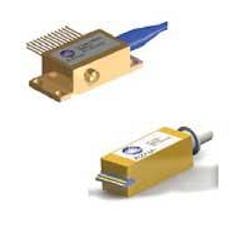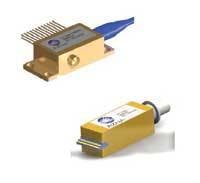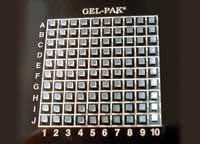Chirp-managed laser enables 10 Gbits/sec without DCF
By Matt Vincent
Available in a 13-pin/GPO butterfly package and an XFP pluggable transmission optical subassembly (TOSA) mini-package, Azna’s DM200 1550-nm chirp-managed directly modulated laser (CML) is designed for upgrading metro networks without using dispersion compensation. The device essentially pairs a DFB laser with the company’s optical spectrum reshaper (OSR), which filters FM to AM conversion with a high extinction ratio (ER) and low transient chirp.“Chirp, essentially, is frequency which is changing in time. Until now, DFB performance has been masked by transient chirp,” explains Daniel Mahgerefteh, Azna’s chief technology officer at Azna (Wilmington, MA). “Transient chirp really distorts the signal after propagation-that’s why they’ve been limited to a few kilometers of transmission at 10G. What we’ve realized is that hidden in there, there’s also adiabatic chirp, which follows the optical power. Let’s say with a 1-0-1 bit sequence, the ones are going to have higher amplitude; they’ll be blue-shifted relative to the zeroes, which have lower amplitudes-they’ll be red-shifted. And the magnitude of that shift is called the ‘adiabatic chirp.’ The laser, at least at adiabatic chirp, kind of follows the bit sequence.”
According to the company, optical networks typically require some form of dispersion management for transport over more than very short distances; that frequently means dispersion compensation fiber (DCF). The company contends that in addition to being fixed in dispersion value, DCF is often bulky, has high loss, and is prone to cause nonlinearities at high optical powers. Moreover, when networks are reconfigured, DCF engenders a need to re-manage dispersion.
“Service providers are interested in upgrading their systems from 2.5G to 10G, but they don’t want high capital expenditure up front,” observes Mahgerefteh. “If they want to go to 10G, they’re going to have to put in DCF. The fiber’s lossy, so they’d have to add amplifiers to compensate for the loss. This would make sense if you’re putting in a system and populating it with 32 channels right up front; the cost would make sense, because compensating fiber compensates for all the channels at the same time.
“But there isn’t that much capacity upgrade at 10G. You’re going to have one channel, maybe two-you’re not going to have that many. So they’d much rather have a technology that says, okay, here’s a transmitter, you don’t have to put in DCF, just take out your 2.5G cards at the transmit-receive side, and you don’t have to take a truck roll. The upgrade cost now becomes the cost of changing your line cards.”
The DM200 is design to make such a scenario possible. The device supports extended long-reach (LR) and metro regional applications. According to the company, compared to lithium niobate duobinary products, its CML is more tolerant to low optical-signal-to-noise ratio and provides equipment vendors with footprint, power consumption, and cost savings advantages.
“I think one of the reasons the progress has been fast, and we’re getting deadlined in already, is that the technology lends itself to being relatively easy to manufacture. We don’t have fabrication, because we can use chips that are out there-the chip is a standard 10-Gbit DFB chip,” explains Mahgerefteh. “As far as performance, nobody else can beat this 200 km. There’s duobinary modulation that can also reach the same distance, but it uses lithium niobate and some pre-coating, and it’s complicated, and it can certainly never fit inside a TOSA. So as far as power consumption and size, our performance is a little bit better.”
At OFC/NFOEC in March, Azna demonstrated how its CML could generate continuous detectability of 10-Gbit/sec data transmission through 675 km of standard singlemode fiber, without relying on the use of DCF. “This was a collaboration with Lucent,” explains Mahgerefteh. “They were using our DM200. In addition to that, they were using electronic dispersion compensation. They also had their own tunable dispersion compensators at the receiver. With all of that together, they stretched [the transmission] to 675 km.”
The company’s other 1550-nm CML products include the DM80 for 10-Gbit/sec 100-km (1,600-psec/nm) LR, metro regional, and long-reach (LH) applications and the DM600 for 2.5-Gbit/sec 640-km metro regional and LH applications. The products are currently available for sampling.Azna’s CML technology extends the reach of 10-Gbit/sec directly modulated lasers to beyond 100 km by managing the lasers’ various chirp properties.
Color-coded duplex patch cords
The CWDM duplex patch cords and patch-cord sets are fully intermateable with any standard coupling adapter product and provide high stability under a range of application conditions. In compliance with EIA/TIA 455 and 604, IEC, and Telcordia 326 standards for performance and reliability, the patch cords use only tight-tolerance pre-radius zirconia ferrules in the connectors to ensure low loss and ease of use. They’re available in LC and SC versions and come in nine different color-coded clips to color-match connections to different CWDM channels and minimize misconnections.
Alliance Fiber Optic Products (AFOP), Sunnyvale, CA, www.afop.com
FTTP fiber management system
The Orbital fiber management system takes a radial fiber approach to fiber distribution structures, routing all the fibers from a central hub located on the main panel, with adapter interfaces placed in a circular array around the hub. The routing scheme creates a “one fiber length fits all” solution for installers, allowing MPO splitter modules to be routed from any one splitter output to 384 homes. The routing also allows simple reuse of any fiber path at any future date without fear of fiber tangle.
OFS, Norcross, GA, www.ofsoptics.com
High-responsivity PD chips
For FTTX and 10-Gbit/sec applications, X-tra Small 300×350-µm photodiode chips provide high responsivity, low capacitance, and low-bias voltages of typically 1.5 V and occupy less space on TO-headers, thanks to the small chip footprint. Telcordia GR-468-qualified, the chips come in three designs: The PDCS80T-XS has a 5-GHz bandwidth for digital and analog FTTX receivers and 4-Gbit/sec Fibre Channel modules; the PDCS60T-XS has a large 60-µm active area, low 200-fF capacitance, and 10-GHz bandwidth for 10GBase-LRM applications; and the PDCS32T-XS has a 12-GHz bandwidth addressing 10-Gigabit Ethernet, 10G Fibre Channel, and OC-192/STM-64 applications. The tradeoff between detector-area size and low capacitance can provide better sensitivity and larger bandwidths for long-wavelength multimode applications like the emerging 10GBase-LRM standard.
Using proprietary Grand-Ex coating technology, the Telcordia GR-1221-qualified super-PON filter chip achieves high isolation of >35 dB for FTTH triple play services. The technology includes an ion beam-splitter process for ideal film structure, a high-precision optical-thickness monitor, and an automatic deposition control architecture.
Santec, Komaki, Japan,
www.santec.com
Low-loss optical switches
Based on patented Micro-Actuation Sensing System and Direct Beam Steering technology used in 16×16 optical switches, the 32×32 low-loss optical-switch sets come in symmetric (N×N) and asymmetric (N×M) formats. The multimode optical switch is available as a 16×16 tray and OEM module for 50- or 62.5-µm core fiber. Instrumentation-grade variable optical attenuation and power monitoring are optional; users can set attenuation per switch path or maximum power per output port, controlled from a GUI. This functionality is integrated into a 19-inch rack-mounted tray, enabling simplification of test and measurement infrastructure.
www.polatis.com
Optically clear UV-curable adhesive/coating
A 100% reactive system, the UV15-7 one-component, optically clear, non-yellowing, UV-curable polymer does not contain any solvents or other volatiles. When exposed to a source of UV light of adequate wavelength and intensity, it cures almost instantaneously. Producing tough, durable bonds, the low-viscosity liquid provides excellent adhesion to many different substrates. It is not inhibited by air and cures at room temperature. The adhesive/coating comes in half-pint, pint, quart, gallon, and 5-gal containers and is available in syringe applicators.
Master Bond, Hackensack, NJ,
www.masterbond.com
Wavelength-selective 1 x 4 multiport switch
The WSS 5200 HI-PLC-based 1×4 wavelength-selective switch module’s small-form-factor industry-standard interfaces and multiport capability allow upgrading from existing wavelength-blocker-based solutions. The switch can be combined with standard passive optical modules to provide a built-in upgrade path to multi-degree connectivity. It offers wide, flat passbands over its full attenuation range, supporting more than a 40% increase in wavelengths, and is compatible with a minimum of 32 cascaded modules at 10 Gbits/sec and 16-module cascades at 40 Gbits/sec.
Metconnex, Ottawa, Ontario,
www.metconnex.com
MEF9 UNI specification conformance test suite
For testing conformance to the Metro Ethernet Forum’s new MEF9 test specification, the N2X N5590A CTS test suite provides more than 300 test cases for E-line and E-LAN services, saving test engineers hours of programming needed to verify that the services can be reliably delivered in a multivendor multiservice environment and comply with the Carrier Ethernet MEF1 specification. Test engineers can focus on resolving implementation problems in the network equipment instead of debugging the test setup.
Agilent Technologies, Palo Alto, CA, www.agilent.com



